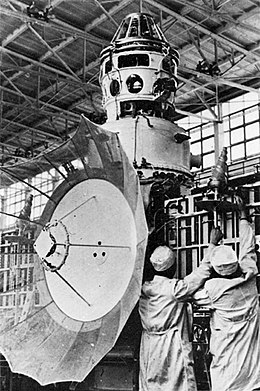
Back Wenera 8 Afrikaans فينيرا 8 Arabic Венера 8 Bulgarian Venera 8 Catalan Veněra 8 Czech Venera 8 Spanish Venera 8 Basque Venera 8 Finnish Venera 8 French ונרה 8 HE
 Assembly of Venera 8 | |
| Mission type | Venus lander |
|---|---|
| Operator | Lavochkin |
| COSPAR ID | 1972-021A |
| SATCAT no. | 5912 |
| Mission duration | Travel: 117 days Lander: 50 minutes |
| Spacecraft properties | |
| Spacecraft | 4V-1 No.670 |
| Manufacturer | Lavochkin |
| Launch mass | 1,184 kilograms (2,610 lb)[1] |
| Landing mass | 495 kilograms (1,091 lb) |
| Start of mission | |
| Launch date | 27 March 1972, 04:15:06 UTC[1] |
| Rocket | Molniya-M/MVL |
| Launch site | Baikonur 31/6 |
| End of mission | |
| Last contact | 22 July 1972 at 09:32 UT (landing) + 50 min., 11 sec. when transmission ended |
| Orbital parameters | |
| Reference system | Geocentric |
| Semi-major axis | 6,591 kilometres (4,095 mi) |
| Eccentricity | 0.03732 |
| Perigee altitude | 194 kilometres (121 mi) |
| Apogee altitude | 246 kilometres (153 mi) |
| Inclination | 51.7° |
| Period | 88.9 minutes |
| Epoch | 27 March 1972 |
| Venus lander | |
| Landing date | 22 July 1972, 09:32 UTC |
| Landing site | 10°42′S 335°15′E / 10.70°S 335.25°E |
Venera 8 (Russian: Венера-8 meaning Venus 8) was a probe in the Soviet Venera program for the exploration of Venus and was the second robotic space probe to conduct a successful landing on the surface of Venus.[2]
Venera 8 was a Venus atmospheric probe and lander. Its instrumentation included temperature, pressure, and light sensors as well as an altimeter, gamma ray spectrometer, gas analyzer, and radio transmitters.
- ^ a b Siddiqi, Asif (2018). Beyond Earth: A Chronicle of Deep Space Exploration, 1958–2016 (PDF) (second ed.). NASA History Program Office.
- ^ Harvey, Brian (2007). Russian Planetary Exploration History, Development, Legacy and Prospects. Springer-Praxis. pp. 115–118. ISBN 9780387463438.
© MMXXIII Rich X Search. We shall prevail. All rights reserved. Rich X Search